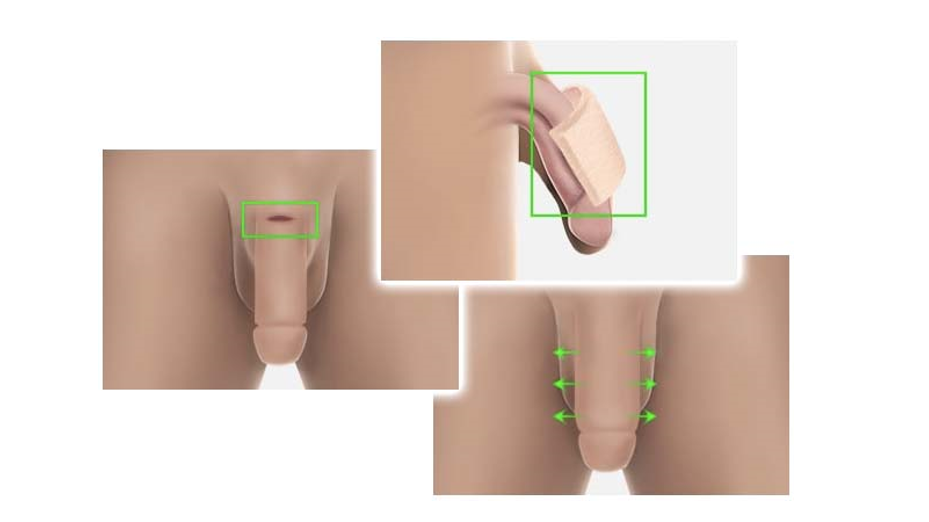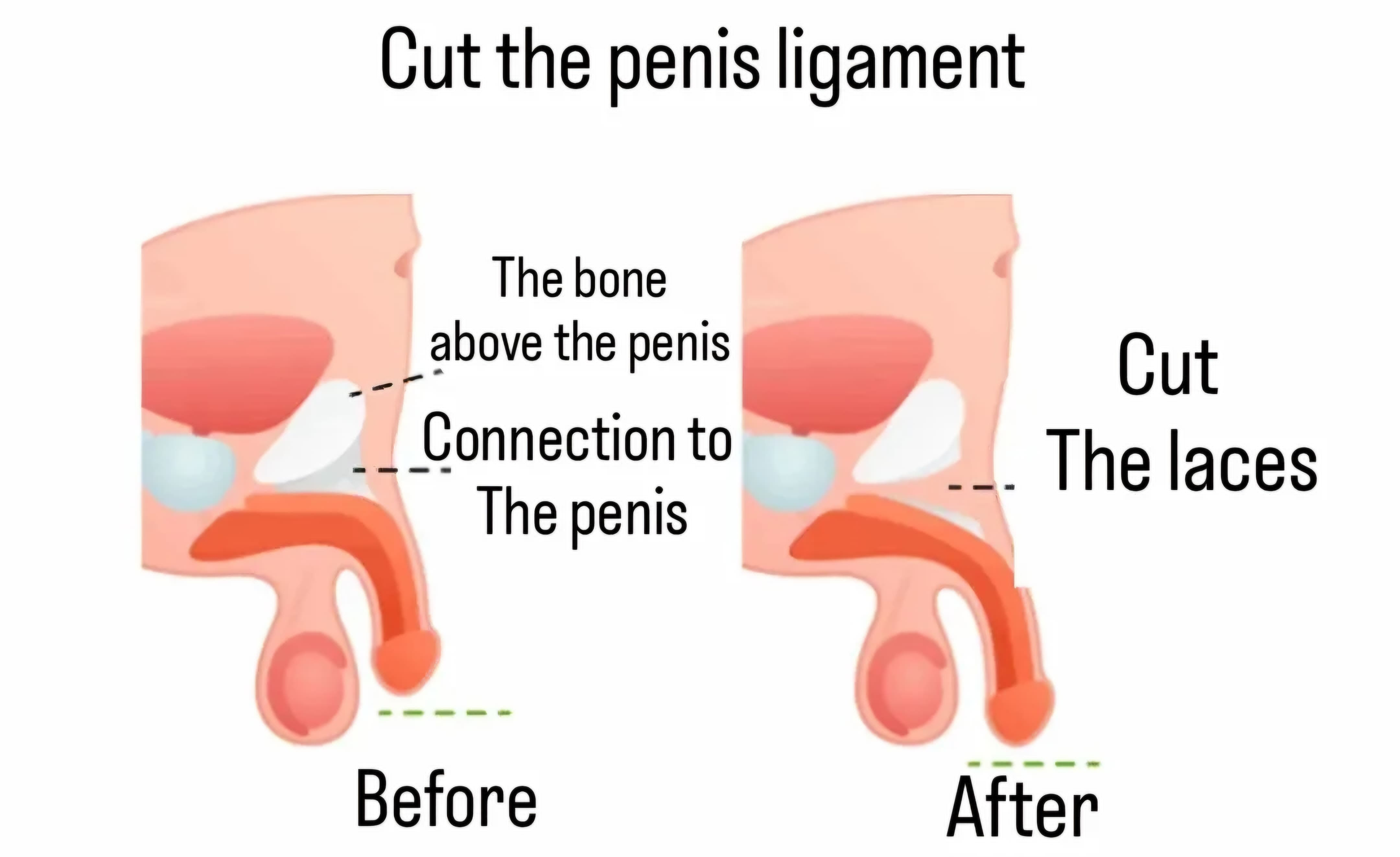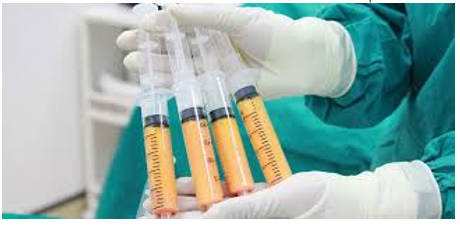There are two methods for this:
1- Injection of Biofiller derived from the patient's blood.
2- Injection of Hyaluronic Acid.
Biofiller Injection derived from the patient's blood:
In the past, the most common method of penis enlargement was using fat taken from the body and injecting it into the penis. However, due to the need for anesthesia, pain, and bruising in the areas where the fat was taken, as well as fat dissolution problems, new methods have been sought. In this context, the latest methods involve using a filling material called Biofiller derived from the patient's blood.
Here's how the preparation and application are simplified:
1- Blood is drawn from the patient (as needed) - 2 minutes.
2- These samples are transferred to tubes similar to those used in PRP and concentrated by centrifugation - 20 minutes.
3- The final material extracted from heat and cold-rich fibers is passed and prepared for use - 40 minutes.
4- Local anesthesia is applied to the penis for the patient for 1 to 2 minutes.
5- The semi-solid extracted material is injected under the penile skin - 15 minutes.
Generally, blood is taken from the arm, and the material is prepared while the patient rests, then the prepared material is injected into the penis in about 20 minutes. After the procedure, the penis is covered with an elastic bandage for up to 3 days. After the procedure, there is no pain and no effect on erection or sensation.
There is no incision or scar in this procedure. The patient can return home to work on the same day. At the end of the procedure, the penis is wrapped with an elastic bandage and this bandage is kept for about 3 days. There is no pain after the operation. There is no loss of erection or sensation after this procedure.
However, in this method, lumpy or hard areas may occur under the penile skin where the injection is made. To prevent this, patients are advised to massage themselves. In case of any troublesome lumps or gaps, these areas can be corrected with a second session after about a month.
Although the technique of this procedure is the same for everyone, its permanence varies from person to person. However, its durability is very good. Although there is a loss of 20-30% within one year, most patients retain 80-90% of their fillings for more than two years. To be honest, since this method has been used for almost two years, we still do not know its long-term durability. Perhaps it could last a lifetime.
In this method, according to the patient's desire:
- Natural Thickness (Natural/Minimum): The circumference increases by about 2 cm
- Average Thickness: The circumference increases by about 3.5 cm
- Maximum: The circumference increases by approximately 5 cm
Blood is drawn according to the required amount for enlargement. However, if someone has a 12 cm penis length and wants to increase its thickness moderately, they may need about 50 ml of material, while another person with a 16 cm penis length for the same thickness increase may need about 80 ml of material. Therefore, the amount of blood used is determined based on a medical examination of the natural length and thickness of the penis, and accordingly, the appropriate amount of blood is used. Generally, the doctor decides on the amount of material used based on the patient's desire to increase thickness.
Filling and injection procedures are one of the most common methods in the field of cosmetic medicine. One of the materials commonly used in these procedures is hyaluronic acid. This material is characterized by its gelatinous texture and its ability to retain water, resulting in an increase in size in the injected area. Although this material is commonly known for use in facial filling, it is also used to increase penile thickness.
A very simple procedure.
1- First, local anesthesia is injected at the base of the penis: for about 1-2 minutes.
2- The ready-to-inject material is injected under the entire penile skin: 15 minutes
The stability period of the injected material usually ranges from 6 months to one year. Generally, about 90% of the thickness increase is lost by the end of the first year.
This procedure enjoys the same care as outlined for Biofiller injections.
One of the common drawbacks among all other methods such as fat injections, Biofiller application, and hyaluronic acid injections is their lack of permanence and the formation of distortions in the shape of the penis. Therefore, the solution for patients who want a level and partially rigid surface is permanent sealing with these materials.
The material we use in our clinic is prepared using materials that the body will not reject (purified from living cells of human skin) in a laboratory environment. These materials used in this method are surgically installed under the entire penile skin (without wrapping the lower urinary tract) and sutured there. Thus, a level and permanently sealed penis is obtained.
If only enlargement is desired, an incision is made in the area where the old circumcision scar is located, and the penile skin is opened. All penile skin is peeled off and the materials are placed under the skin and secured there with stitches. If lengthening is also performed, the incision is made from the upper part of the penis where the hair is, and the tendons are cut for lengthening here. The penile skin is pulled from the inside and the prepared materials are placed around the penis and secured with stitches.

The procedure using materials takes about 30 minutes. And when lengthening is also done, the time increases to about 45 minutes.
The procedure can be performed under general anesthesia or spinal anesthesia.
The patient can leave on the same day or the next day, and the elastic bandage wrapped around the penis is removed the next day by the patient himself. Sexual activity is restricted for 2-3 weeks.
After the procedure, there is no decrease in erection or loss of sensation. However, although side effects such as infection or bleeding are rare in all surgical procedures, they can occur here as well. Routine antibiotics and rest after the procedure are recommended to prevent this.
Patients may experience pain during erection in the early period due to stitching of the material. Although this pain usually lasts for less than a month, it may persist for up to three months.
It lasts for a lifetime.
The thickness of the material is about 0.5 cm. This results in an increase in diameter of about 1 cm and an increase in circumference of about 2.5 cm. While the thickness of other filler material can be increased according to the patient's desire, a consistent increase is obtained here.
A study on penile size conducted by a research team under my supervision is the widest study in Turkey and the fourth in the world (relationship between penile size and physical standards in 2276 healthy young men. International Journal of Erectile Dysfunction Research. May-June 2012). In this study, which we conducted on 2276 healthy young men, we sought answers to questions on this subject.
The answers were as follows:
- The average length of the penis in the erect state is 13.8 cm (±1.5 cm).
- There is no relationship between penile length and body measurements (meaning that penile length is not related to height, weight, or body mass index).
- There is no statistically significant difference between geographical regions and cities in Turkey.
These were the results of our study. In many other studies, it is also mentioned that the average penile length is about 13 cm. These differences are due to the method of measurement.
Although the average is so, a penis longer than 10 cm is considered extremely normal for an adult male. A penis shorter than 10 cm is considered small, and one shorter than 7 cm is considered very small and is significantly associated with hormonal or developmental problems in males.
The general assumption is that those with a small penis should undergo penile lengthening surgery. However, the procedure known as penile lengthening does not actually increase the length of the penis, but rather brings the inner part of the penis out a few centimeters. However, the larger the penis, the larger the internal part, so the size of the expansion is related to the size of the penis.
As mentioned above, reference can be made to the natural rates of penile length. Here are some notes about it:
Penile lengthening surgeries on penises longer than 10 cm are satisfactory, and an increase in length can be obtained the larger the penis. For example, expansion can range from 2 to 4 cm for a person with a 12 cm long penis, while it can reach 3-4 cm for a person with a 15 cm long penis.
In penises shorter than 7 cm, I suggest first performing a genetic and hormonal examination, as patients in this condition may not benefit much from the mentioned procedure.
Penile lengthening surgery is actually a procedure to bring the inner part of the penis out rather than expanding the penis. Through this procedure:
1- The suspensory ligaments are cut.
2- The skin is stretched.
3- Lower abdominal fat is reduced.
4- Excess skin between the testicles and the penis is cut.
An increase in length can be achieved by performing one or more of these procedures.
Cutting the suspensory ligaments: A incision is made in the upper part of the penis (the hairy area) about 2-3 cm in length straight or in a "V" shape. The ligaments that attach the penis to the pelvis are partially cut from this area to lengthen the penis. The skin is then sewn back together. If a straight incision is made, it is sewn back straight, and if it is cut in a "V" shape, it is sewn back in a "Y" shape to lengthen the skin as well. The V-Y incision is considered more effective in lengthening.
If there is excess lower abdominal fat causing a push on the penis, this fat can be removed by liposuction to make the penis more prominent.
If there is excess skin between the testicles and the penis causing a short appearance of the penis, this excess skin can be cut in the same session to achieve further lengthening of the penis.

In case of performing the surgery only for lengthening, the average time is about 30 minutes, but lengthening and enlargement surgeries are usually performed together for patients. When both are done together, this duration can reach about 1.5 hours depending on the method of enlargement.
The surgery can be performed under various types of anesthesia, whether general anesthesia or local anesthesia (spinal anesthesia). In cases where materials are used in the surgery, local anesthesia may sometimes be sufficient.
After the surgery, patients stay in the hospital for one night unless they encounter any additional problems, then they are discharged the next day. The penis is left in a rubber sheath for 2-3 days and then removed. Sexual activities (intercourse or masturbation) are restricted for 3-4 weeks.
There is no loss of erection or sensitivity after the surgery. However, although rare, complications such as infection, bleeding, and wound dehiscence may occur. To prevent this, the patient should rest as directed and take antibiotics after the surgery.
The main problems after lengthening surgery are related to pain in the pelvic area due to cutting of the ligaments. Although pain may vary from person to person, it typically lasts for one week but may extend up to a month. Patients can return to daily life at home within 1-2 days, but returning to work and normal life may take from 1 to 10 weeks.
The increase in length in these procedures averages between 2-4 cm. However, it may be less or more. An experienced surgeon can estimate the increase approximately based on the tension of the ligaments, penis size, surrounding fat condition, skin tension, and body condition during the preoperative examination. In other words, it is incorrect to confirm the increase in length before seeing the patient.
1- Those suffering from advanced erection problems.
2- Those under the age of 20.
3- Those who wish to undergo enlargement surgery and are not circumcised.
4- Those suffering from health problems that prevent surgery.
5- Those taking blood clotting inhibiting medications.
If we want to increase the size in a certain area of our body, we need to use our own tissues (i.e., fatty tissues under the skin) or take advantage of ready-made materials. If we prefer to use our own tissues, this is usually done by injecting the fat that has been drawn (liposuction) from areas such as the abdomen or waist, filtering the fat, and preparing it for injection into the skin under the penis. However, if this area does not contain sufficient fat, fat can be drawn from the inner thighs. The extracted fat is filtered, and unwanted parts are separated to prepare a fluid containing fat cells and stem cells. This fluid is injected around the penis from all directions at a 360-degree angle.

The size increase procedure with fat takes approximately one hour. However, this procedure is usually performed simultaneously with penile lengthening surgery, where the duration of the surgery in this case can reach 1.5 hours. This time is particularly increased due to the process of collecting and preparing the fat.
Special anesthesia for penile injection is not required. However, using general anesthesia for fat suction area is the most convenient method for patient comfort and ease of surgery for the surgeon.
Generally, the patient is kept in the hospital for one night, then discharged the next day. A rubber band surrounding the penis is left for 2-3 days before removal. Sexual activities (intercourse or masturbation) are prohibited for 3-4 weeks.
Patients may experience pain in the fat suction area for up to 2-3 days and the possibility of bruising for one week. In some rare cases, fluid leakage may occur through the small incision made for the suction, but this can resolve spontaneously. Although there is no loss of sensation or erection after the procedure, some complications such as infection or bleeding may occur, but they are rare. It is usually recommended to take antibiotics and rest after the procedure to prevent these issues. In case of lumps or hardening in the skin under the penis after the injection procedure, a minor surgical procedure can be performed after about 6 months to correct it.
Although fat injection technique is generally symmetrical, the duration of fat varies from person to person. While more than 50% of the fat may evaporate within 6 months for some patients, others may retain 80-90% of the fat for years. On average, 20-40% of the fat is evaporated over a period ranging from 6 months to a year.